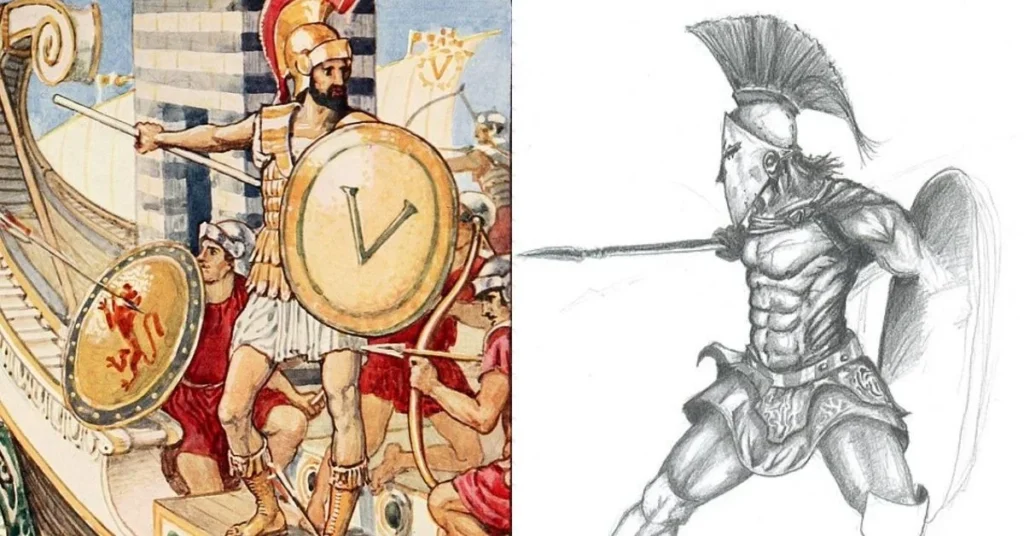Sparta, an ancient Greek city-state, was renowned for its legendary warriors. The Spartan society revolved around unwavering loyalty to the state and devoted military service. Male Spartan citizens were singularly devoted to the role of a soldier, initiating military training at the age of 7. Given their infamous reputation and the tales of epic battles, the question often arises: How Tall Was the Average Spartan Warrior?

Both Plutarch and Xenophon assert that the Spartans were on average taller than their counterparts. By examining helmets, equipment, descriptions, and shields, historians have estimated the height of Spartan hoplite warriors.
The predominant method involved comparing shields and considering the shield’s coverage from the neck to the thigh of the adjacent soldier in the Spartan phalanx. Through these studies, the average height of a Spartan Warrior is estimated to be between 5 feet 7 inches (171 cm) and 5 feet 9 inches (175 cm).
Genetic and Environmental Factors Affecting the Average Spartan Height
The Spartans’ towering stature as compared to their neighboring populations was due to a combination of eugenic practices and dietary advantages. Their ruthless selection process, which involved eliminating babies who were considered weak or unfit, ensured the survival of genetically superior individuals. The scrutiny of newborns for birth defects and overall size allowed Spartans to selectively propagate a physically robust population.
Nutrition also player an important role in giving Spartans the height advantage. Their more nutritious diet in the Mediterranean, especially during critical growth stages, set them apart. While other Greek city-states heavily relied on fish and seafood, potentially limiting protein quality intake, Spartans had access to diverse protein sources.
The inland pastures and forests offered opportunities for hunting wild boar, fowl, and deer, supplementing their diet with high-quality proteins that contributed to enhanced growth. By meticulously choosing the best foods and incorporating substantial protein from varied sources, Spartans inadvertently equipped their bodies to surpass average genetic limitations.
The combined effect of eugenic practices and a nutrient-rich diet during crucial growth phases led to the Spartans’ average height of 5 feet 7 inches and weight of 165 lbs(60-70kgs), setting them apart from their Mediterranean counterparts and other Greek city-states.
Plutarch on the Physical Characteristics of Spartans
The Greek-Roman biographer Plutarch wrote extensively about the Spartan way of life in his book, “On Sparta,” which remains one of the most significant sources about Sparta in modern times. He provided insights about their training, weapons, culture, and diet.
According to Plutarch, Spartan boys adhered to a simple diet, at times even reaching the brink of starvation. Their military training commenced at the tender age of seven when they were separated from their families to be groomed in the art of war.
Luxuries were scarce for young Spartan boys, who went without shoes or garments, foraging for their own sustenance. This austere lifestyle, marked by hardship, contributed to their physical and mental fortitude. The necessity to conduct food raids occasionally underscored the Spartan commitment to survival under challenging conditions, a principle endorsed by Plutarch.
Spartan rulers intentionally provided meager food rations to young boys, guided by the belief that slender bodies were more likely to grow taller. Plutarch’s account emphasizes the Spartan commitment to creating a disciplined and resilient society through rigorous training to forge exceptional physical and mental capabilities in its citizens.
Research Into Ancient Greek and Spartan Skeletal Remains
In 1944-45, forensic anthropologist John Lawrence Angel conducted a seminal study on Ancient Greek skeletal remains, yielding average heights of 5 feet 4 inches(162 cm) for men and 5 feet(153 cm) for women. Subsequent excavations at the Magna Graecia colony-city of Metapontum, following Angel’s death, confirmed these findings.
The Metapontion necropolis unveiled average heights of 5 feet 5 inches(165 cm) for adult males and 5 feet 2 inches(156 cm) for females, along with body weights of approximately 60-65 kg for males and 50-55 kg for females, corroborating Angel’s earlier results.
In Athens’ Kerameikos area lies the Tomb of the Lakedaemonians, housing the remains of thirteen Spartans who perished in 403 BC during the conflict at the Peiraeus. Further studies on Spartan remains revealed an average height of 5 feet 7 inches(170cm) that surpassed their neighboring counterparts by 2 inches (5 cm).
Archaeological and scientific evidence thus underscores the unique physical attributes of Spartans, portraying them as notably taller compared to the broader Ancient Greek population.
How Tall Was Leonaidis, the Legendary King of Sparta?
Leonidas gained fame as King of Sparta, especially for his role at the Battle of Thermopylae where he died in 480 B.C.E., becoming a heroic figure. His rumored height of six feet and robust physique stemmed from rigorous military training and a mythical connection to Hercules.
The movie “300,” featuring Gerard Butler portraying Leonidas at 6’2” (188 cm), further solidified this perception. However, the actual height of Leonidas remains unknown due to a lack of any written records and skeletal evidence.
